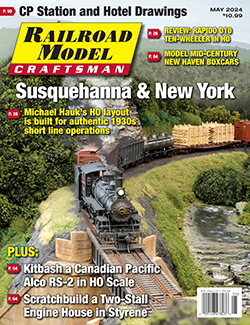 by Patrick Lawson/photos as noted, scale drawings by the author
by Patrick Lawson/photos as noted, scale drawings by the author
Canada’s first transcontinental railway was completed in 1885 when Canadian Pacific connected Montreal with Vancouver, B.C. The Shuswaps is an area of British Columbia located west of the Rockies, east of the Pacific Ocean and north of the Okanagan on the nation’s longest highway – the Trans-Canada Highway. The town of Sicamous was established in the Shuswaps at the Narrows linking Salmon Arm Lake to Mara Lake. The name “Shuswap” derives from several bands of indigenous people who were part of a much larger group called the Secwepemc or Shuswap. They were semi-nomadic tribes that crossed the Rockies to hunt buffalo. On the plains they were called Schickamoos. In fact. in 1872 a provincial map names the Narrows the “Schickamoos Narrows,” which in early history was known to mean the “meeting place of Indians.” Now named “Sicamous,” the narrows was a natural site to build a community.
Fur traders arrived in the early 1800s but had no interest in settling in the area. Gradually, Westerners began to settle as paddle wheelers plied the lakes as the primary form of transportation. In the 1860s gold was discovered in the nearby Columbia River Basin. This led to an influx of gold seekers, and Sicamous became a supply center.
Canadian Pacific reached Sicamous in 1885, and built the Sicamous Narrows Bridge across the narrows at mile 44.1. With the building of the railway came the need for large quantities of lumber for bridges, structures and ties. Since the area around Sicamous was heavily forested, additional sawmills were quickly set up to meet that demand. As the forests were cleared, settlers mainly from Finland arrived, and Eagle Valley in Sicamous became their home. They established small farms and it wasn’t long before the area was supplying vegetables to cities as far away as Calgary and Vancouver. In 1892, Shuswap became a railway junction point with the completion of CP’s Shuswap & Okanagan Railway which ran south to Okanagan Landing near present day Vernon, B.C.
In 1885, when the CP arrived in Sicamous, they built a tiny station which served until 1897 when it was destroyed by fire. The railroad quickly hired architect Edward Maxwell to design a new station that also included a hotel. The new station and hotel would have 28 rooms and the design would be somewhat similar to the Moose Jaw Station in Saskatchewan, which Maxwell had previously designed. Construction began in 1898 and the new station was opened in 1900. The new station was built partially over the beach supported on pilings. As the tracks were built on a bench cut into a steep hillside, there was very little space between the tracks and the lake. The fanciful architecture included turrets and balconies overlooking the Sicamous Narrows.

ABOVE: The exterior of the Sicamous Station and Hotel was clad in sawn cedar shingles. It was built on wood piles overlooking Lake Shuswap. In 1908, the structure was extensively renovated and rebuilt in a Tudor style. —Courtesy Sicamous & District Museum & Historical Society
The new structure featured in these drawings had a large veranda that wrapped around three sides of the building, affording great views of Shuswap Lake and Sicamous Narrows. One can imagine patrons sitting in wicker chairs on warm summer evenings sipping drinks as they gazed out over the lake. Stairs led down from the veranda to the beach below to provide access to boats and canoes. On the track side the veranda continued on the same level to become the station platform. Like many stations of the day, a semaphore was attached to the roof above the platform.
Immediately apparent when looking at photos of the station were the sawn cedar shingles that covered the exterior of the building. The roof too appears to be clad with sawn cedar shingles. The octagonally peaked turrets had diamond-shaped leaded glass windows. The dining room had large windows with views of the narrows. At either end of the station on the floor above the veranda were screened-in porches.
The impressive structure only lasted for eight years as the station was extensively remodeled in 1908. A third story was added which gave the hotel an additional 25 rooms. A new baggage room was built where the north- and east-facing veranda had been, and the lobby and dining room took the rest of the veranda facing north and west. The renovations removed the hip and pyramid roofs and replaced them with gables. The turrets were removed, and the result was a box-like structure with a Tudor-style exterior. The original sawn cedar shingles on lower exterior walls were preserved, but the upper became stucco and boards.
Canadian Pacific operated the Tudor-style station and hotel until 1956. Train service to the Okanagan was eliminated in the late 1950s and main line passenger train service was reduced. In 1964, the remodeled station was torn down. Today, the main activities in the Sicamous area are outdoor recreational pursuits such as sledding, houseboating, hiking, swimming, and biking.
>> Download the scale drawings here.



